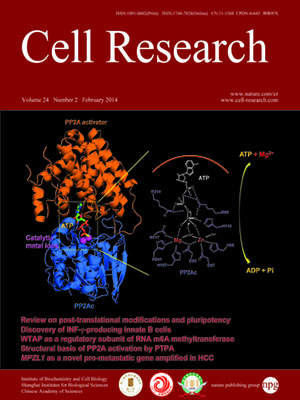
Volume 24, No 2, Feb 2014
ISSN: 1001-0602
EISSN: 1748-7838 2018
impact factor 17.848*
(Clarivate Analytics, 2019)
Volume 24 Issue 2, February 2014: 251-253
LETTERS TO THE EDITOR
Stereotyped distribution of midbody remnants in early C. elegans embryos requires cell death genes and is dispensable for development
Guangshuo Ou1,2,*, Christian Gentili3,* and Pierre Gönczy3
1National Laboratory of Biomacromolecules, Institute of Biophysics, Chinese Academy of Sciences, 15 Datun Road, Chaoyang District, Beijing 100101, China
2Tsinghua-Peking Center for Life Sciences, School of Life Sciences, Tsinghua University, Beijing 100101, China
3Swiss Institute for Experimental Cancer Research (ISREC), School of Life Sciences, Swiss Federal Institute of Technology Lausanne (EPFL), Lausanne CH-1015, Switzerland
Correspondence: Pierre Gönczy, Email: Pierre.Gonczy@epfl.ch; Guangshuo Ou,(guangshuo.ou@gmail.com)
The midbody is a structure formed within the intercellular bridge towards the end of cytokinesis1. Microtubules within this bridge are then severed on one side of the midbody during abscission, thus generating a midbody remnant in one of the resulting daughter cells. Midbody remnants persist long after cell division and accumulate preferentially in stem cells, induced pluripotent stem (iPS) cells, and cancer stem cells2,3,4. Upon induction of differentiation, midbody remnants are degraded by autophagy or released into the extracellular milieu in some tissue culture cells, and it has been proposed that such removal is critical for enabling a differentiation program2,3,4. However, the fate of midbody remnants in a developing organism remains elusive, and whether their presence plays a role in cell fate determination in vivo is not known.
10.1038/cr.2013.140
FULL TEXT | PDF
Browse 2376


